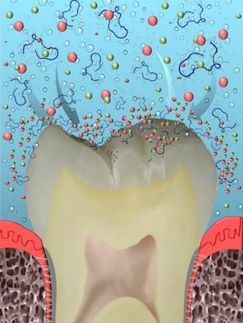Convergent Evolution: Team of BGU and Max Planck Researchers Discover Crayfish Teeth Covered with Enamel
Advertisement
A team of Israeli and German scientists from Ben-Gurion University of the Negev and the Max Plank Institute of Colloids and Interfaces, Potsdam, have found an enamel-like layer in the mandibles of freshwater crayfish. The newly discovered structure bears an astonishing resemblance to human enamel. In an article entitled “Enamel-like apatite crown covering amorphous mineral in a crayfish mandible” the team published their findings in Nature Communications.
Crayfish uses enamel based on calcium phosphate
Enamel is by far the hardest mineralized tissue in the human body. Human bones and teeth gain their incredible strength and hardness from the use of calcium phosphate minerals. In contrast, freshwater crayfish, like most invertebrates, reinforce their exoskeletons with a different calcium-based mineral: calcium carbonate (limestone). Dr. Amir Berman from the Department of Biotechnology Engineering and Prof. Amir Sagi from the Life Sciences Department and the National Institute for Biotechnology in the Negev in cooperation with Dr. Barbara Aichmayer and her colleagues from the Max Planck Institute in Potsdam have investigated the mandibles of the Australian freshwater crayfish Cherax quadricarinatus.
Dr. Shmuel Bentov from the BGU team discovered that this species of crayfish protect their teeth against wear in a very specific and surprising manner: they produce a highly mineralized protective coating based on calcium phosphate which is strikingly similar to the enamel of vertebrates.
“Enamel is the best solution for coating masticatory (chewing) organs. We assume that in the course of evolution both vertebrates and this crayfish independently developed enamel-like tissues to address similar needs. Crustaceans discard their old teeth during the molting events several times throughout their life, and grow new exoskeletons and teeth regularly and rapidly.”
Protective layer of calcium phosphate is very similar to human enamel
The mandibles of the freshwater crayfish are part of their exoskeleton, which is regularly molted and renewed to allow growing to their next growth stage. The crayfish exoskeleton is embedded with the mineral calcium carbonate in amorphous form. This is of vital importance: the amorphous - the disordered, (non-crystalline) state of the mineral - facilitates its dissolution before molting. The dissolved calcium carbonate is partly resorbed and used for the buildup of the new exoskeleton. However, the amorphous mineral is also less hard, hence is inappropriate material for making teeth. Therefore, there is a need for a hard coating to cover the tooth surface.
The BGU team has discovered that the solution that had evolved in the crayfish is coating the tooth surface with a layer of elongated calcium phosphate crystals that are organized perpendicular to the tooth surface, forming a dense, organized structure, reminiscent of enamel. The existence of such a substance in invertebrates was unknown until now. As a result, the crayfish tooth mechanical performance is remarkably similar to enamel. The crystalline structure, uniform orientation and dense packing of the crystals confer upon these layers the required hardness and strength. For these reasons, enamel is considered a “masterpiece” of biological mineralization.
The “enamel” in the crayfish tooth serves as a protective layer for the softer under layer that is made, similar to the rest of the exoskeleton, from amorphous calcium carbonate.
The BGU team is presently investigating the formation process of this material and its ramifications.

























































